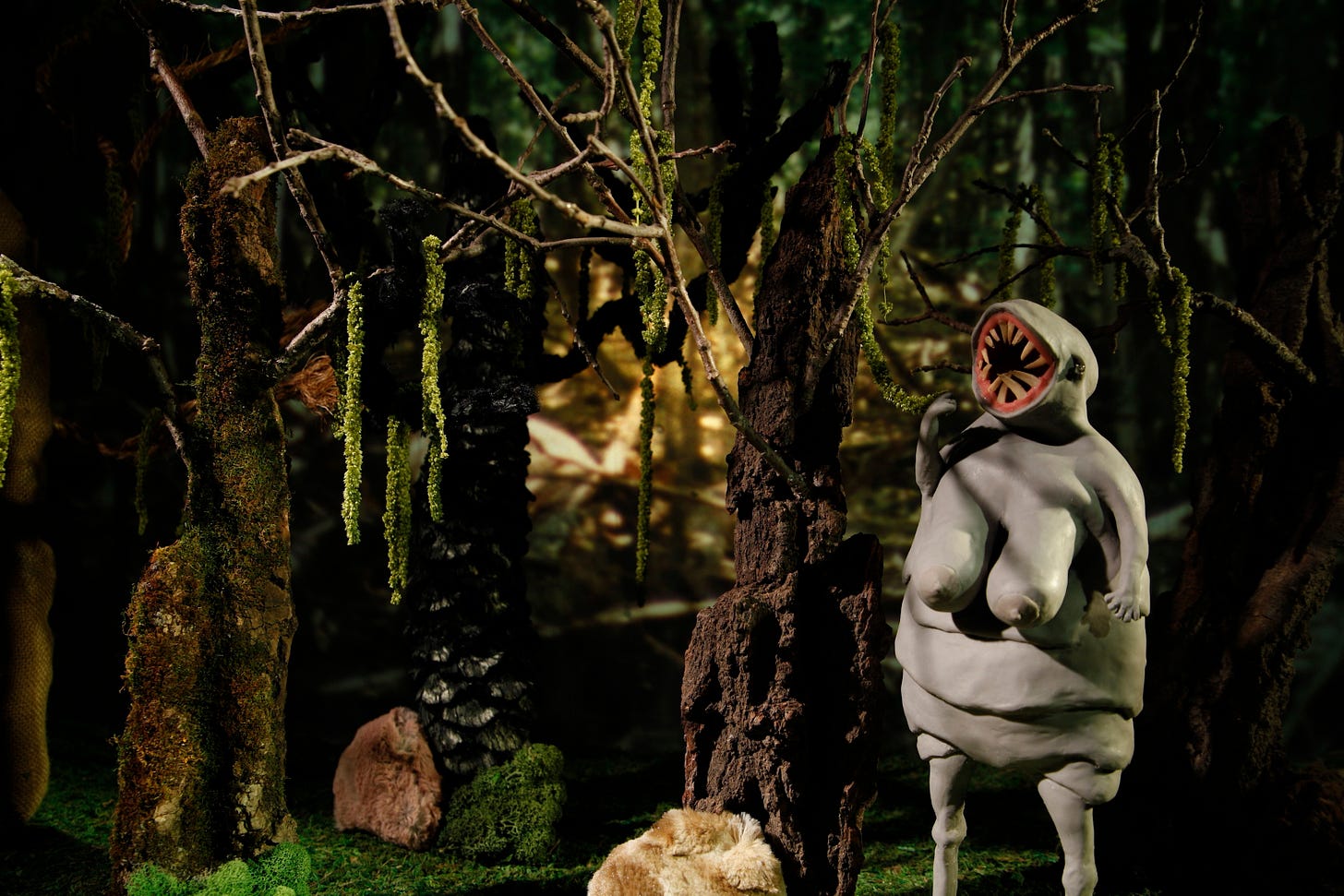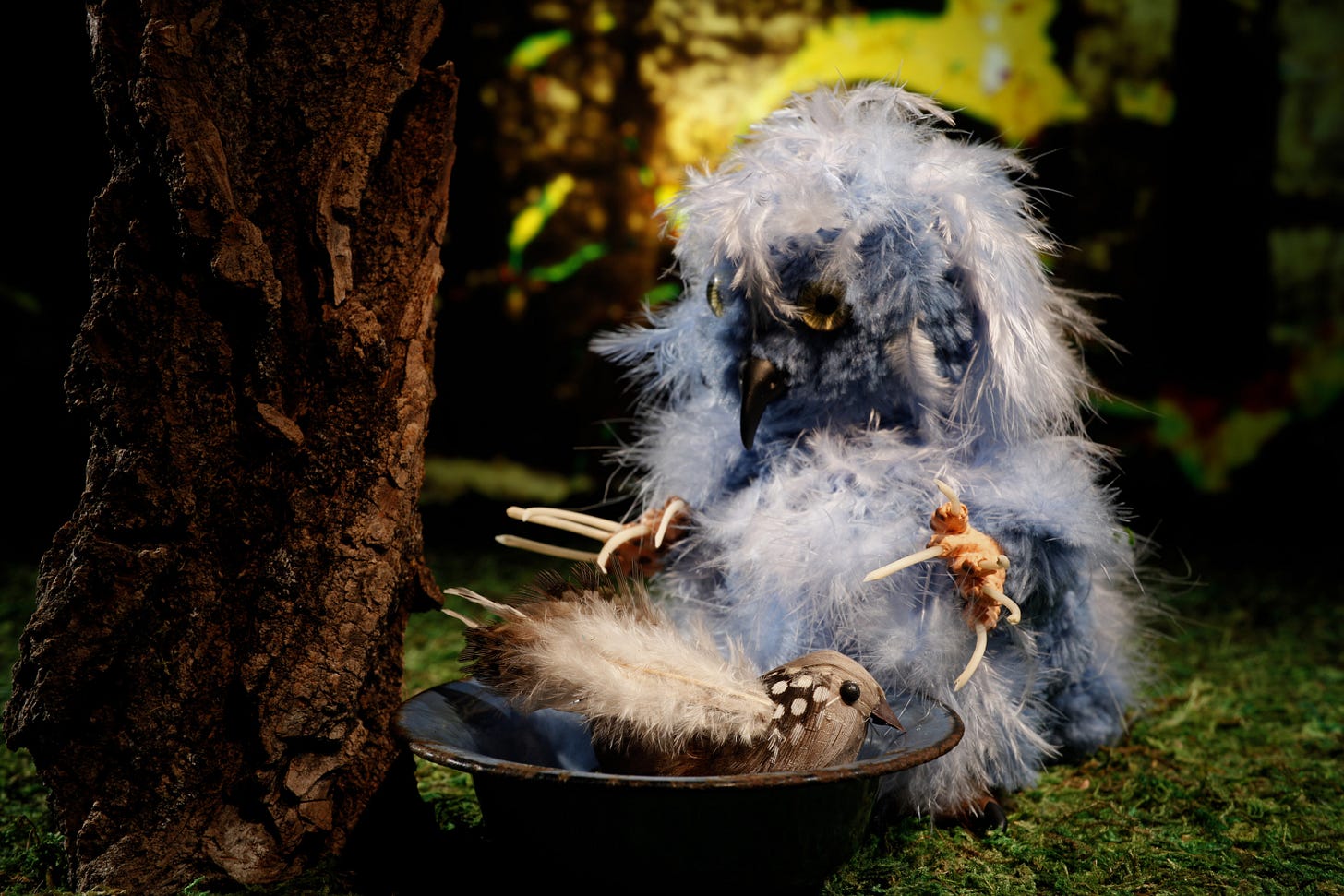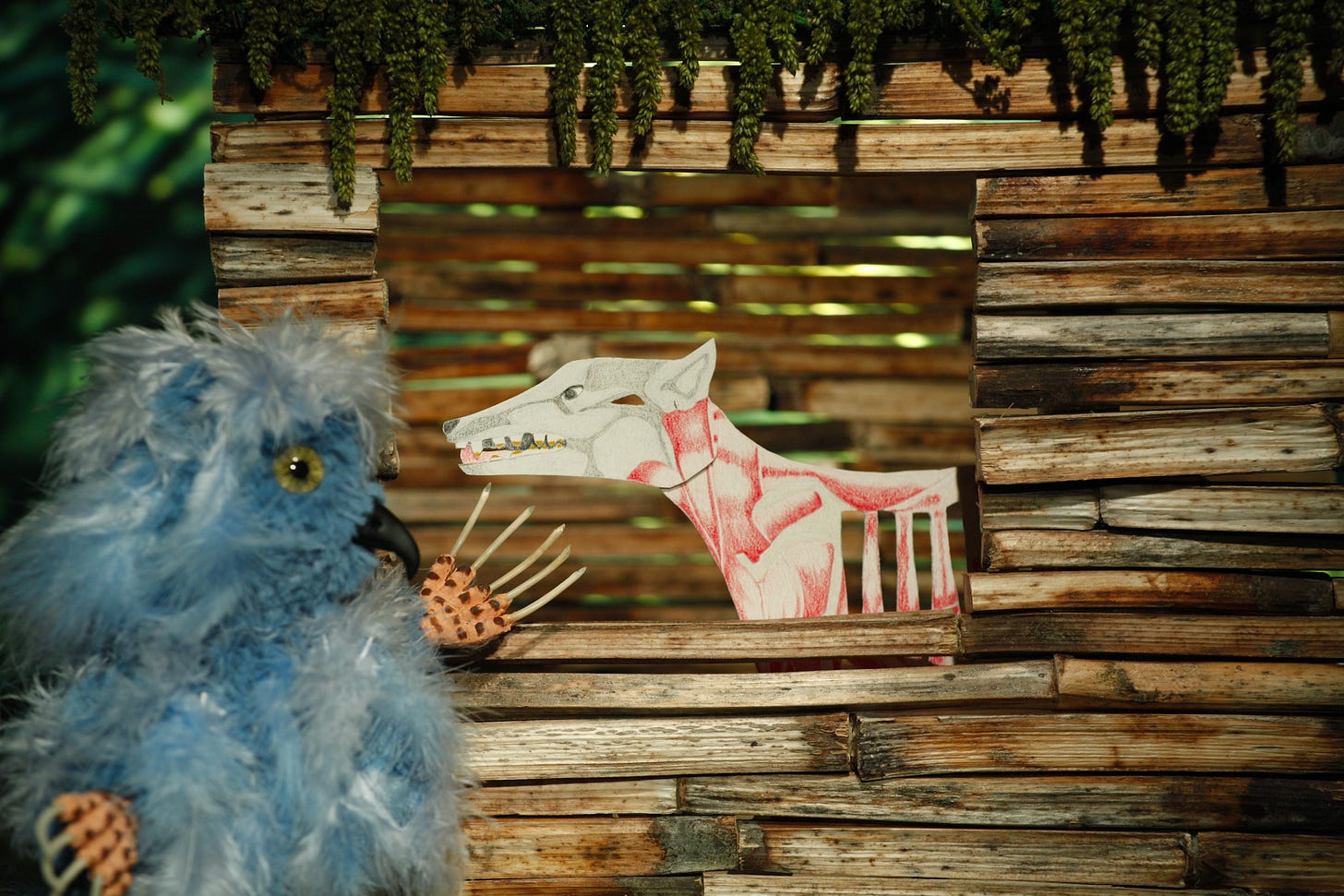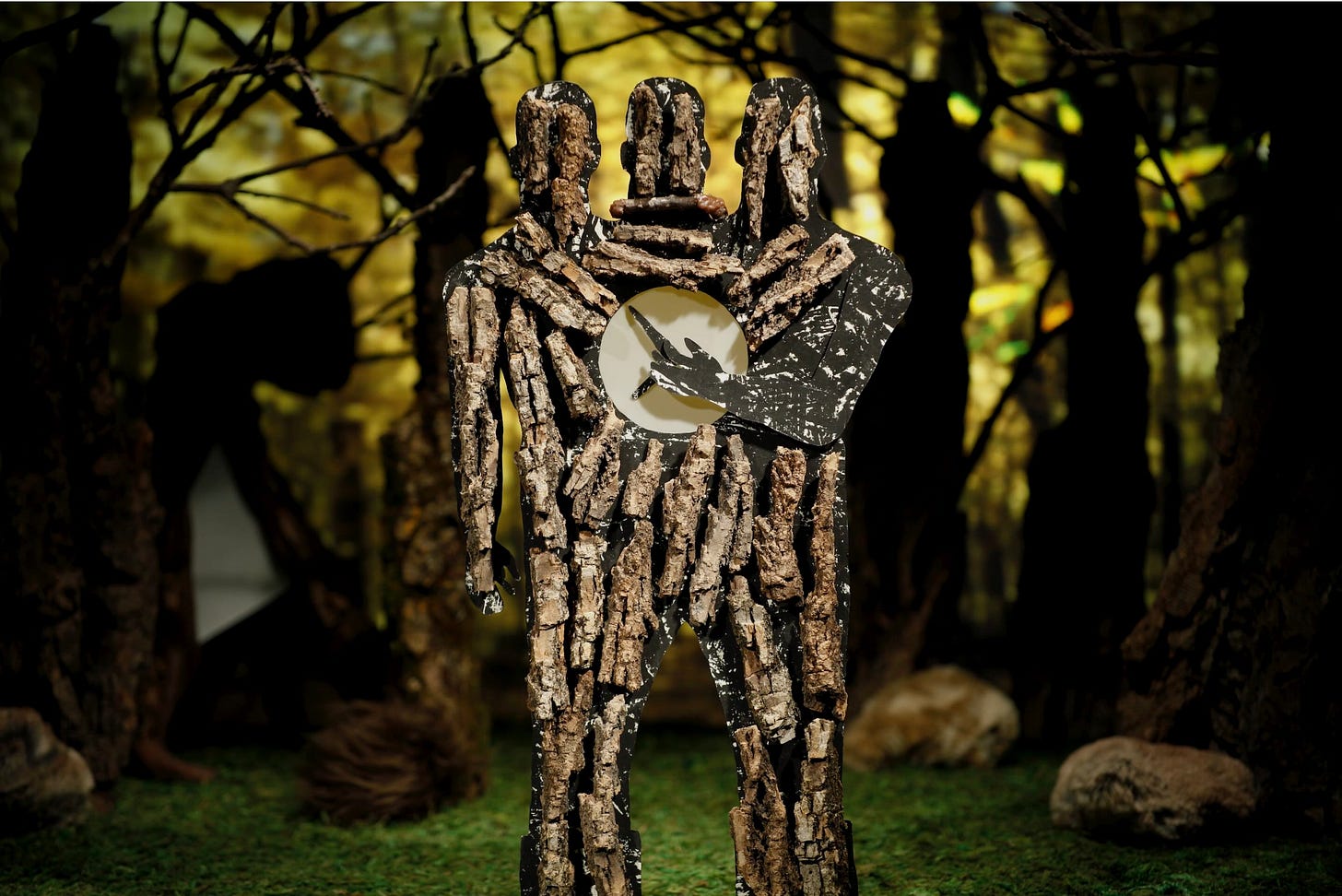In The Garden Sees Fire, Kiera Faber’s mysterious and fascinating 15 minute animation, we are drawn into a dark fairy tale world, set in a forest, a world of dangers and deep, pulling appetites. She deftly blends multiple animation techniques to create her world: cell animation of pencil drawings, stop-motion animation of puppets, film projected behind and onto the settings, and paint applied directly to the filmstrip. The puppets are made from fiber, rope, and natural materials such as seed pods and feathers. Faber works in each of these animation techniques with equal assurance, and, even more impressively, she successfully integrates them into a coherent world, all of the parts fitting together seamlessly. This technical finesse, combined with her sensitivity to the mythical qualities inherent in materials and her beautifully poetic sense of storytelling, make her an artist with a unique voice, and the ability to vibrantly bring her visions to life.
This world is populated by some striking creatures. Grove is an odd creature, made from grey clay, with six fingers on each hand and a face which is simply one giant, gaping mouth, ringed with teeth, like a lamprey. Since she has long, pendulous breasts, she might be a figure of a devouring mother, and in any case is an archetypal female who is pure appetite. A dog, with visible muscles and permanent gaps in her body, roams the forest, looking like the embodiment of Hunger, the force which drives all of life.
Two animals which live in the forest, looking like fuzzy kids’ toys, are a brown teddy bear and a blue bird with skeletal fingers. Later, the bear is revealed to have a little girl living inside of her. Why does this girl disguise herself as a bear? Does she don this costume in her fantasies, or in her dreams, in order to live out a magical drama that wouldn’t be possible for an ordinary girl? The film, as a whole, certainly has the feeling of a child’s fantasy world.
In the forest birds bob up and down, suspended on visible wires, giving the film the feeling of a cinematic puppet show. Rather than turning her camera on nature itself, Faber shows us an intricately constructed and animated imaginary world, a world in which a child’s fears and fantasies about nature, as well as her intuitive apprehension about nature’s inexorable laws, are enacted in the form of parables, personal fairy tales, warning us of dangers and temptations, not only of the natural world, but of our own human nature. The wires, fur, and other construction materials of this fabricated world emphasize the imaginative effort that the child uses to invent her personal myths and fables.
The action of the film consists of a series of vignettes, symbolic cautionary tales which feel like warnings, or expressions of deep-seated cultural beliefs. Grove regurgitates some of the plants she swallowed into a bowl, and the bird and bear transform the contents of the bowl alchemically, until it becomes pure water. This could be seen as an expression of the endless recycling of materials in the forest, where fungi and bacteria break down dead plants and animals, and transform them into the materials for new life. Viewed this way, illness is not the opposite of health, it is the flip-side of health, two different phases of a single process.
The bear and bird build a wood hut where they confine the hungry dog. The shadowy figure of Time, composed of three figures, like the Fates, with a clock-face at its center, hands an ax to Grove, enabling her to destroy the hut. Is this one of the tricks which Time plays on us? We may successfully contain our appetites for a short while, but, inevitably, they return to dictate our actions.
Later, the bear feeds green leaves to the dog, and parts of her body fall off, crashing with the sounds of breaking glass. This might be an image of the assuaging of desire, the taming of Hunger, which (temporarily) loses its hold on us if we properly attend to its demands.
The soundtrack, blending droning accordions, wistful songs which sound like forgotten nursery rhymes, and rustling and crunching noises which might come from the forest floor, creates a kind of home-grown aural theater of the woods which perfectly supports the tone of the imagery.
Faber deliberately structures these stories so that they can’t be reduced to a single interpretation. Unlike conventional fairy tales, nothing conclusive happens in the stories. Neither do they teach a clear moral, or have villains or heroes. They share the impersonal immorality of nature herself. Taken as a whole, the episodes do not link together to tell a clear story, but are structured poetically, to evoke interconnected emotions and themes. Capturing the flavor of fairy tales, but leaving out the actual tales, Faber is able to activate the same primal fears and desires as we might feel as children, hearing a story, but she gives us the space which need, as adult viewers, to construct our own meanings from these open-ended parables.
As the film comes to a close, true to its open-ended structure, you will not come away with a definitive message. Instead, the film gives us a portrait of what it is like to live as an animal, an embodied creature, living within an ecosystem, and subject to the laws of nature. There are eternal forces structuring the system: Time, Hunger, Death, the law of regeneration. It’s like a game of rock, paper, scissors: each of these forces may, for a time, mitigate the force of the others, but none are allowed to gain lasting ascendancy. It is this perfect structural balance which enables nature’s sustainability, its infinite power to correct imbalances, its eternal evolution into greater refinement. This awesome perfection makes the passing needs of individual animals, of us, irrelevant, and it likewise makes our endless fretting about needing to “save the planet” into a moot point.
The Garden Sees Fire presents us with a child’s fearful and awe-struck apprehension of nature, and it exhibits an attitude which is characteristic of European fairy tales: the forest as a wild and dangerous realm, outside the safety of the home. (Faber, living in the US, is originally from Luxembourg.) But just as our childhood selves form the foundations from which our adult selves emerge, these childhood fantasies are expanded into a wider and deeper appreciation of the justness and perfection of nature’s ruthlessness. We transcend the viewpoint of the scared animal in the forest. We’re able to pull back and appreciate the system as a whole. Parts of the garden may catch fire, but this is only a phase in the continual process of restoring balance. Faber’s special gift is to allow us to glimpse this transcendence, peeking out from our darkest memories.
My articles on experimental film are freely available to all, but are supported by monthly and annual donations from readers. Please consider becoming a paid subscriber to support my work. Thank you.








